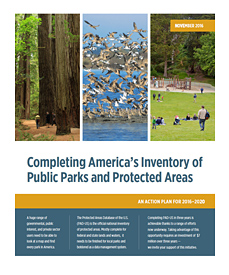The PAD-US team will hold a public briefing on January 9, 2017 for U.S. Department of the Interior staff and others, as part of the DOI Office of Policy Analysis (PPA) Seminar Series. The event is open to the public and remote viewing is available – feel free to share this notice with your networks.
PAD-US Coordinator Lisa Johnson will lead the session, which also includes representatives from the Federal Lands Working Group discussing PAD-US as part of the National Spatial Data Infrastructure, and others talking about how PAD-US helps with wildfire response, recreation, conservation and federal agency data management. An information flyer is available, as is a notice on the DOI website.
The presentation will be Monday, January 9th, 2017 12:15-1:45 PM Eastern Main Interior Building Rachel Carson Room, and can also be live viewed at https://www.doi.gov/events. It will be available afterwards as a video recording at: https://www.doi.gov/ppa/seminar_series/video.
Read more
